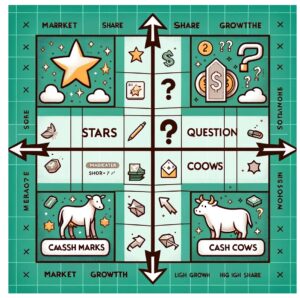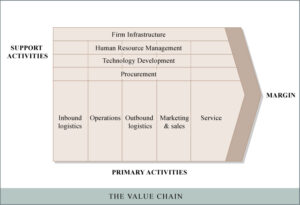Resource-Based View (RBV)

The Resource-Based View (RBV) of the firm is a managerial framework used to determine the strategic resources available to a company. It highlights the internal environment of a firm in terms of its resources and capabilities. The main idea behind RBV is that firms possess resources, a subset of which enables them to achieve competitive advantage, and a further subset which leads to superior long-term performance. Resources that are valuable, rare, inimitable, and non-substitutable (VRIN criteria) can provide sustainable competitive advantage.
Here are the key components and implications of the RBV:
- Resources and Capabilities: In RBV, resources are defined as the tangible and intangible assets that a firm controls, which it can use to conceive and implement its strategies. Capabilities, on the other hand, refer to the firm’s capacity to deploy resources using organizational processes to effect a desired end. These resources and capabilities together form the basis for a firm’s strategy.
- Types of Resources: Resources can be tangible or intangible. Tangible resources include physical assets like buildings and equipment, while intangible resources include assets like brand reputation, patents, and the skills and knowledge of employees.
- Competitive Advantage: According to RBV, for resources to provide a firm with a competitive advantage, they must be valuable, rare, inimitable, and non-substitutable. This means that resources must contribute to creating value for customers, be unique to the firm, difficult for competitors to copy or acquire, and cannot be easily replaced by other resources or capabilities.
- Sustainability of Competitive Advantage: The RBV suggests that the sustainability of a competitive advantage depends on the barriers to imitation and the ability of competitors to substitute the critical resources. Factors such as complexity, culture, unique history, and causal ambiguity can act as barriers to imitation.
- Strategic Implications: RBV has several strategic implications for firms. It suggests that firms should look internally to determine their strengths and weaknesses, invest in developing unique capabilities and resources, protect and leverage those assets to create competitive advantages, and continuously evaluate and adapt their resource base in response to changing market conditions.
- Critiques and Limitations: While the RBV provides a robust framework for understanding competitive advantage, it has been criticized for being too inward-looking, ignoring the importance of industry structure and external market forces. Additionally, the theory assumes resource heterogeneity and immobility within an industry, which may not always be the case.
In summary, the RBV of the firm offers a perspective that emphasizes the importance of unique internal resources and capabilities in achieving and sustaining competitive advantage. It complements other strategic frameworks that focus on external factors, providing a comprehensive view of what drives firm performance.



